|
|
Scanning Procedure (P-215)
| Article ID: ART113297 |
| |
Date published: 05/11/2015 |
| |
Date last updated: 08/17/2015 |
Description
Follow these steps to scan a document using CaptureOnTouch Lite (Windows)
Solution
Follow these steps to scan a document using CaptureOnTouch Lite (Windows) - Set the Auto Start switch at the rear panel of the scanner to ON and then connect the scanner to the computer.
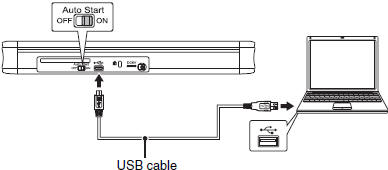
If necessary, connect the power supply USB cable or the AC adapter (sold separately).
- Open the feed tray, turn ON the scanner, and then load the document.
For details, see “How to Place Documents”.
When you open the feed tray, the Start button on the scanner lights and the auto play screen appears.

If you are using Windows XP and you set the Auto Start switch to ON before connecting the scanner to the computer, a message requesting that you restart your computer may appear when you turn ON the scanner. You can continue normal use even if you click [No] and do not restart the computer.
- Click [Open folder to view files].

The [ONTOUCHLITE] folder opens.
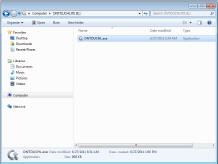
- Double-click [ONTOUCHL.exe].
CaptureOnTouch Lite starts, and the main screen appears.

Do not close the feed tray before the main screen of CaptureOnTouch Lite appears.

 | The auto play screen may not appear in some operating environments. In such cases, open the [ONTOUCHLITE] drive in Windows Explorer, for example, and start the application directly by double-clicking ONTOUCHL.exe.
Depending on your operating system, the drive name may not be [ONTOUCHLITE]. Open the drive on which ONTOUCHL.exe is located, and start the application directly. |  | Depending on your operating system, [CaptureOnTouch Lite] may appear in the auto play screen. In such cases, double-click [CaptureOnTouch Lite] to start CaptureOnTouch Lite. |
- Set the scanning method.

| ? | Specify whether to enable continuous scanning. When previewing the scanned image or splitting up a large document to scan in parts, select [ON] to enable continuous scanning. | | ? | Specify whether to scan the document in full auto mode. When you want to specify arbitrary scanning conditions, select [OFF] and configure the scanner settings. (See "Scanner Settings") |

If you configure scanning conditions that require a large amount of the computer’s memory, scanning may be disabled. If an error message appears due to insufficient memory while scanning is in progress, exit the application and try scanning again using different scanning condition settings.
- Click the Start button.
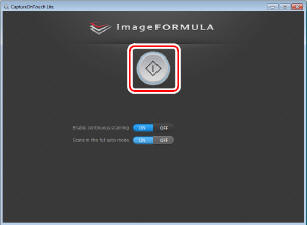
Scanning of the document starts.When scanning of the whole document is completed, the output settings screen appears.

If a document is scanned when [Enable continuous scanning] is set to [ON], the continuous scanning screen (see "Operation in Continuous Scanning Screen") appears when scanning of the document is finished.
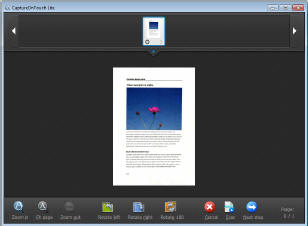
If you place the next document and click [Scan], scanning of the document starts.
When scanning of all the documents is finished, click [Next step].
- Configure the settings related to output and then output the scanned images.
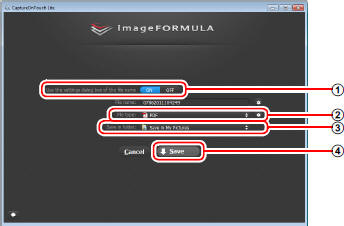
| ? | Specify the file name for the scanned images. If [Use the settings dialog box of the file name] is set to [OFF], enter the file name directly into the file name field. If you set [Use the settings dialog box of the file name] to [ON] and then click  , you can specify a format for creating file names. , you can specify a format for creating file names. | | | 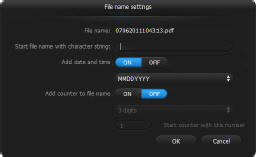 | | ? | Select the file format. If you select a file format other than BMP, you can click  to configure advanced settings. to configure advanced settings. | | | PDF | | | 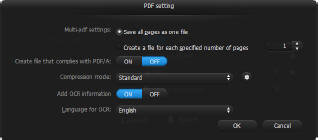 | | | In [Multi-pdf settings], specify whether to save the scanned images as a multi-page file ([Save all pages as one file]) or single page files ([Create a file for each specified number of pages]). | | | In [Compression mode], specify the compression mode ([Standard] or [High Compression]) for the PDF file. You can click  to display a dialog box for specifying the compression rate. to display a dialog box for specifying the compression rate. | | | TIFF | | |  | | | In [Multi-tiff settings], specify whether to save the scanned images as a multi-page file ([Save all pages as one file]) or single page files ([Create a file for each specified number of pages]). | | | JPEG | | | 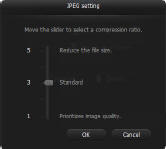 | | | You can specify the compression rate of JPEG images. | | | PPTX | | |  | | | You can specify whether to add OCR information to the scanned images. | | ? | Specify the storage location for the scanned images. | | ? | Output the scanned images. |

 | Clicking [Return to top] returns to the main screen of Scan First. |  | If you click [Open storage folder], the folder in which the saved scanned images were saved opens. |
|